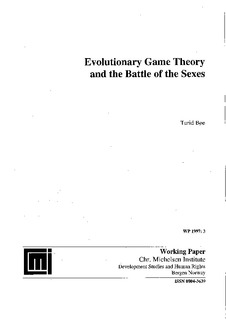| dc.description.abstract | This paper presents an outline of different approaches within evolutionary game theory and sees these approaches in relation to the problem of choosing among multiple equilibria in normal form games. More specifically the paper extends the analysis of Mailath, Kandori and Rob (1993) addressing 2x2 player symmetric games to cover 2x2 player asymmetric games. Utilising an evolutionary model with a finite and equal number of players within two different player populations and allowing for mutations perpetuating the system way from its deterministic evolution, we show that for the asymmetric "battle of the sexes" game the long run equilibrium (for large populations) chosen satisfies the Harsany and Selten (1988) criterion for risk dominance. In games with player-specific risk, that is in games where the players face identical risks regardless of the strategy chosen, but where the players from the different population face different risks, the population size N does not influence the equilibrium chosen. In such games the long run equilibrium is the equilibrium with the largest surplus product. | |
